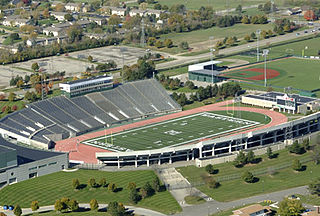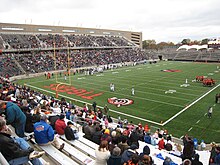
Alumni Stadium is a football stadium located on the lower campus of Boston College in Chestnut Hill, Massachusetts, approximately 6 miles (9.7 km) west of downtown Boston. It is the home of the Boston College Eagles. Its present seating capacity is 44,500.

Scott Stadium, in full The Carl Smith Center, home of David A. Harrison III Field at Scott Stadium, is a stadium located in Charlottesville, Virginia. It is the home of the Virginia Cavaliers football team. It sits on the University of Virginia's Grounds, east of Hereford College and first-year dorms on Alderman Road but west of Brown College and the Lawn. Constructed in 1931, it is the oldest active FBS football stadium in Virginia.

Fred C. Yager Stadium is a football stadium in Oxford, Ohio, United States. It is home to the Miami University RedHawks football team. It has a capacity of 24,286 spectators, and was built in 1983. It replaced Miami Field, which had been used since 1895 and was the home field for many of the coaches who had made the school famous. The stadium is named for Fred C. Yager, class of 1914, who was the lead benefactor in the project to build the stadium.

War Memorial Stadium, also known as Jonah Field at War Memorial Stadium, is an outdoor college football stadium in the western United States, located on the campus of the University of Wyoming in Laramie.

Kramer/Deromedi Field at Kelly/Shorts Stadium is an American football stadium in Mount Pleasant, Michigan. It serves as the home field for the Central Michigan University Chippewas. The stadium opened in 1972 and holds 30,255 spectators, making it the largest on-campus stadium in the Mid-American Conference. It is located on the southeast part of campus, along with most of the other athletic facilities. The playing surface is named Kramer/Deromedi Field after former coaches Roy Kramer and Herb Deromedi.

Valley Children's Stadium, also known as Jim Sweeney Field at Bulldog Stadium, is an outdoor college football stadium in the western United States, located on the campus of California State University, Fresno in Fresno, California. It is the home field of the Fresno State Bulldogs, who play in the Mountain West Conference.

Rynearson Stadium, nicknamed "The Factory", is a stadium in Ypsilanti, Michigan. It is primarily used for American football, and is the home field of the Eastern Michigan University Eagles. Currently, the stadium has seating for 30,200 people. Standing room is available in the south end zone, allowing for crowds larger than the listed capacity. The stadium is located on the school's west campus, just south of the Huron River.

Waldo Stadium is a stadium in Kalamazoo, Michigan. It is primarily used for football, and has been the home of Western Michigan University Broncos football in rudimentary form since 1914, and as a complete stadium since 1939. It currently has a capacity of 30,200 spectators.

University Stadium is an outdoor football stadium in the western United States, located on the south campus of the University of New Mexico in Albuquerque, New Mexico. It is the home field of New Mexico Lobos football, which competes as a member of the Mountain West Conference.

Walter J. Zable Stadium at Cary Field, named for Walter J. Zable, former member of the College of William & Mary Board of Visitors, is located in Williamsburg, Virginia and is the home of the William and Mary Tribe football team. It is located centrally in the William & Mary campus, adjoining the Sadler Center building and situated on Richmond Road. The stadium is used for football and track & field. It has an official capacity of 12,672 fans. The attendance figures for William and Mary football games are usually inexact, however, since students are not counted among the official results in an accurate fashion. The area of Cary Field behind the stadium was the baseball field for William and Mary until the opening of Plumeri Park in 1999.

W. Max Finley Stadium is the home stadium for the University of Tennessee at Chattanooga football team and Chattanooga FC, a professional Division 3 soccer team. The stadium also hosts various high school sports and musical concerts. It is located in Chattanooga, Tennessee, United States. The stadium, which opened in 1997, has a current capacity of 20,412, and hosted the NCAA Division I National Championship Game from its opening season through 2009, after which the game moved to Pizza Hut Park in the Dallas suburb of Frisco, Texas. The stadium will host the TSSAA Football Championships in 2021 and 2022.

Fisher Stadium is a 13,132-seat multi-purpose stadium in Easton, Pennsylvania. The stadium is home to the Lafayette College Leopards football team. It opened in 1926 as Fisher Field.

Allen E. Paulson Stadium is a 25,000-seat on-campus football stadium in Statesboro, Georgia. It is home to the Georgia Southern Eagles football team and the focal point of Erk Russell Athletic Park.
Bob Waters Field at E. J. Whitmire Stadium is a 13,742-seat football stadium in Cullowhee, North Carolina. It opened in 1974 and is home to the Western Carolina University Catamounts football team. The field itself is named Bob Waters Field. The football facility is located on the south end of the WCU campus and is bordered by Cullowhee Creek on the west side; Jordan-Phillips Field House and WCU Weight Room on its north end, and the Liston B. Ramsey Regional Activity Center on the south end.

Nottingham Field is an 8,533-seat multi-purpose stadium in the western United States, located on the campus of the University of Northern Colorado in Greeley, Colorado. It is home to the Northern Colorado Bears football and track and field programs.

Roos Field is an outdoor college football stadium in the northwest United States, on the campus of Eastern Washington University in Cheney, Washington, southwest of Spokane. It is the home venue of the Eastern Washington Eagles of the Big Sky Conference in Division I (FCS).

Joan C. Edwards Stadium, formerly Marshall University Stadium, is a football stadium located on the campus of Marshall University in Huntington, West Virginia, United States. It currently can hold 30,475 spectators and includes twenty deluxe, indoor suites, 300 wheelchair-accessible seating, a state-of-the-art press-box, 14 concession areas, and 16 separate restrooms. It also features 90,000 sq ft (8,000 m2) of artificial turf and 1,837 tons of structural steel. It also houses the Shewey Athletic Center, a fieldhouse and a training facility. The new stadium opened in 1991 and replaced Fairfield Stadium, a condemned off-campus facility built in 1927 in the Fairfield Park neighborhood.

Washington–Grizzly Stadium is an outdoor college football stadium in the western United States, located on the campus of the University of Montana in Missoula, Montana. Opened 38 years ago in 1986, it is home to the Montana Grizzlies, a member of the Big Sky Conference in Division I FCS.
Sea Foam Stadium is the football field on the campus of Concordia University, Saint Paul in Saint Paul, Minnesota. It opened in 2009, and seats about 3,500 spectators. The Stadium includes a football/soccer field with artificial turf, running track, scoreboard, lights, bleachers, parking, concession facilities, locker rooms, weight room, press box, outdoor plaza, and inflatable dome, somewhat resembling a marshmallow, during the winter months.

Harold Alfond Sports Stadium is a 10,000-seat multi-purpose stadium in Orono, Maine. The Stadium hosts Morse Field, and the Beckett Family Track and Field Complex. It is the home of the University of Maine Black Bears football team.





















